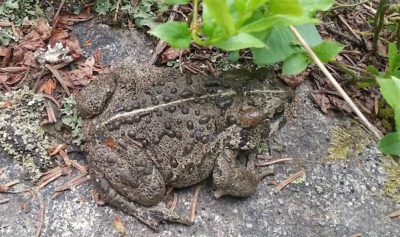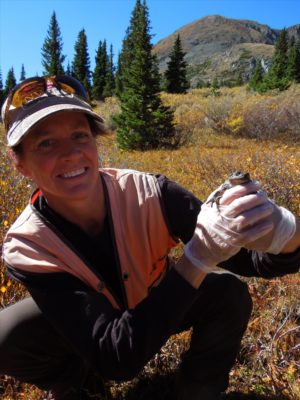
Bryan Malek, USFS, left, and David Downing, volunteer., work to install an informative sign in endangered Boreal Toad habitat earlier this month at the Brown’s Creek trailhead in Chaffee County. Lee Coveney photo.
Life hasn’t gotten any easier for the endangered Boreal Toad – in fact, it’s gotten worse.
The rare amphibian used to be regularly found above 7,000 feet in Colorado and New Mexico, but despite conservation efforts by the Colorado Forest Service, Parks and Wildlife, and volunteer organizations like the Greater Arkansas Nature Association (GARNA), populations appear to be dwindling.
I reported on efforts to save the little toad from potential extinction back in 2015 for Colorado Central Magazine, and heard a presentation on its status from Stephanie Shively, then a Wildlife Biologist working in the Salida Ranger District.

A Boreal Toad in a Chaffee County breeding area. Photo by Lee Coveney.
At the time she said life was tough for this little toad, with habitat loss as well as the threat of the deadly Chytrid fungus, a disease known to have devastated toad and frog populations across the country and globally, in fact.
Recently, on June 30 and July 1, GARNA joined Shively and Rec Adopters volunteers to help install educational signs in critical Boreal Toad habitat designed to help those recreating learn how to prevent the spread of the fungus that threatens the toad.
The project was partially funded through a grant from Chaffee Common Ground. Other partners included Envision Chaffee County, Friends of Browns Canyon, Mt. Princeton Riding Stables, the U.S. Forest Service (USFS) and Colorado Parks and Wildlife (CPW).
In 2021, Shively led a four-hour hike for GARNA members into some habitats of the endangered amphibian to reveal how to mitigate recreational activities’ impact on the toad population.
The fact is, it has been a very long effort to fight the spread of the fungus and save the Boreal Toad from potential extinction.

Stephanie Shively with a Boreal Toad. Image courtesy of GARNA.
Professionals with the Forest Service, CPW, and volunteer groups have searched the wetlands around the state, including areas in Chaffee County for the often hard-to-find amphibian in a broad effort to identify future sites for reintroduction and identify potential sites where the fungus hasn’t impacted populations. Even the Denver Zoo has been part of the effort.
The Cottonwood drainage in Chaffee County was important to this effort, which in the early 2000s involved eight state and federal agencies and the Colorado Natural Heritage Program agreeing to a conservation strategy plan.
The Cottonwood drainage was once an area thought to be Chytrid-free, and some tadpoles were collected and reared at a Native Aquatic Species Restoration facility in the San Luis Valley for later release.
Disappointingly, it was determined back then that the fungus had indeed spread to areas once thought to be free of it.
But there have been successes in protecting the toad habitat and in educating the public about ways to help protect this little toad.
Shively told Ark Valley Voice the signs were funded by the Colorado Parks and Wildlife Wetland Grant, which also helped remove campsites near Boreal Toad breeding sites and helped build a fence of slash material along the Browns Creek Trail to the waterfall.
“This fence will hopefully be relatively low-maintenance and will keep cattle from the Boreal Toad breeding site along Browns Creek. The Forest Service, CPW, GARNA, Envision Chaffee County, Friends of Browns Creek and Upper Arkansas Wilderness Volunteers have all been amazing partners in the project which has been ongoing for several years now” she added.
The signage is one of the final steps, designed to help the public determine the appropriate distance to camp from a wetland or stream.
“Other boreal toad conservation projects this year are the reintroduction success story in the Leadville Ranger District on Tennessee Creek, repair of the historic beaver dam on South Cottonwood Creek to preserve the needed water levels for the breeding toads, project planning for future breeding site dams with the partnership between the U.S. Forest Service, Ecometrics, National Forest Foundation and Envision Chaffee County,” Shively said.
The rescue efforts certainly will continue .
“ The U.S. Forest Service, Bureau of Land Management, Colorado Parks and Wildlife and the Colorado Natural Heritage Program continue to monitor known breeding sites and search for new sites across Lake, Chaffee, and Park Counties throughout the summer season,” she noted.
According to the Forest Service and CPW, there are measures those recreating in habitat areas can take to help this worthy effort.
Some of those include avoiding spreading contamination of the Chytrid fungus by not introducing water or mud from one infected wetland to other wetlands, and working to decontaminate boots, boats, and other equipment used.
For more information on the Boreal Toad, go to the Forest Service or CPW websites or GARNA.org.






Recent Comments